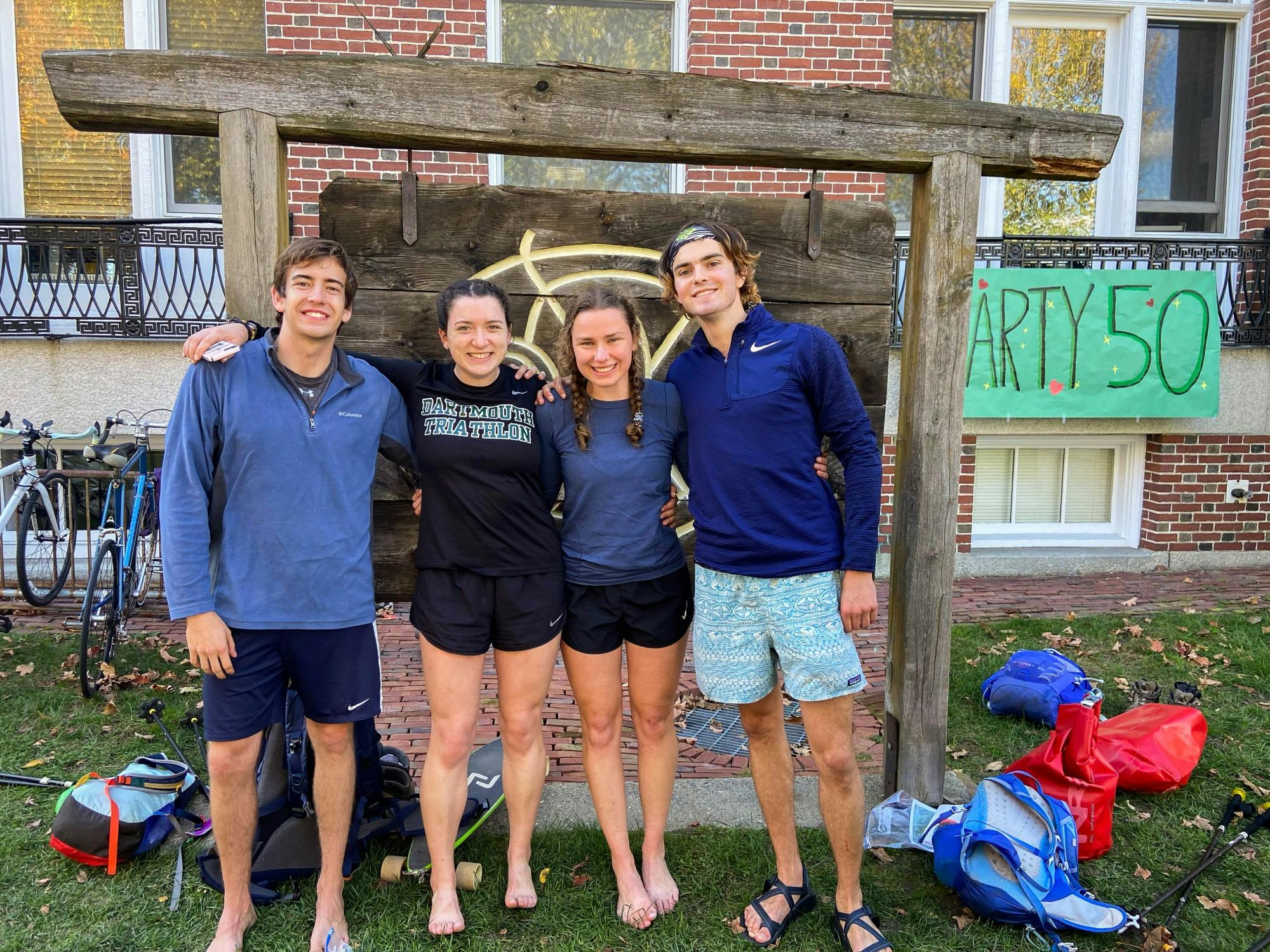This past weekend, the Dartmouth Outing Club organized the Fifty, a challenge that requires hikers to trek 50 miles from the Moosilauke Ravine Lodge to Hanover in just over 24 hours. Katie Gregoire ’23, one of three coordinators for the Fifty, said that the course follows the Appalachian Trail from Mount Moosilauke to the Green and takes most people around 26 hours.
According to Gregoire, groups not only hike over Mount Moosilauke but also Mount Cube, Smarts Mountain, Mount Mist, Holt’s Ledge and Moose Mountain, occasionally encountering five support stations located every six to ten miles. At the end of the challenge, groups touch the DOC sign outside of Robinson Hall, officially completing their journeys.
The support stations ensured that hikers were physically and mentally able to continue and administered first aid for injuries like blisters. They also provided hikers with food and water and a place to drop off personal items like changes in clothes, according to Gregoire.
“The aid stations in particular are really motivating because people are so excited to see you and there’s music and celebration,” said Sarah Hutchinson ’22, who successfully completed the Fifty this past weekend alongside everyone in her group.
This year, eight groups of four people participated in the challenge, Gregoire said. Of the 32 people total who started the challenge, only 13 successfully completed it.
The competition to participate in the Fifty this year was steep, with 44 groups — each of four people — vying for the 8 spots that were awarded on the basis of a lottery system. According to Gregoire, the lottery is weighted in favor of seniors and those who have previously volunteered to staff support stations along the way. However, everyone on campus was eligible, and members of every class year participated.
Gregoire said they were involved in organizing both the fall and summer treks, noting that the fall Fifty ran “smoother” than the summer’s. However, Gregoire added that the conditions of the fall Fifty proved challenging, saying that the fall is a lot “colder and wetter” than the summer.
Nicole Ward ’25, who participated in the Fifty this past weekend, said that her group was in “really high spirits” at the onset of their hike, but soon ran into issues with the weather.
“I didn’t really feel the cold when I was hiking, but any time I stopped, I was literally freezing,” Ward said.
Connor Seeley ’22, who completed the Fifty this past summer, said that completing the challenge was a goal of his before even attending Dartmouth.
“It’s this crazy goal that you can set for yourself, and it’s the only time in your life probably where you’re going to have a team ready to support you to do it,” Seeley said. “It feels like if you don’t do it now, you never will.”
He added that he was glad he did it in the summer instead of the fall, citing the cold.
Participants also reported facing the emotional challenges associated with the long hike. Ward said she hallucinated on the way up Mount Cube.
“I would imagine the small rocks were dogs, and the big rocks were, like, women,” Ward said.
Hutchinson said that her experience as a volunteer for the Fifty during summer term was a major reason why she chose to participate in the Fifty this fall.
“After feeling the energy of the hikers, I decided I wanted to hike it myself,” Hutchinson said.
Volunteer supporter Grace Hillery ’25 said the fall Fifty was a “great experience.”
“The Fifty is the iconic Dartmouth tradition and I wanted to help support it, as well as get support points so that I can do the Fifty in the future,” Hillery said. She added that she wanted to participate this fall but wasn’t selected in the lottery.
Not everyone was able to complete the Fifty this fall. According to Gregoire, some people voluntarily elected not to continue, but most failed to reach time cutoffs — meaning they didn’t arrive at support stations in the time allotted. Gregoire said that the Fifty is inherently risky, and the DOC does not allow hikers to continue into a second night due to the “unacceptable level of risk” involved.
Ward, whose group got lost during the Fifty, described the experience as “dramatic.” She said that her group was hiking up Moose Mountain when she encountered difficulties.
“I passed out,” Ward said. “My vision went black.”
Ward said that she and another group member were “in so much pain” that the other two group members had to navigate.
“We got completely lost and completely off trail,” Ward said. “We have no service and we cannot find our way back on the Appalachian Trail.”
Ward said they were eventually able to get in contact with Gregoire after receiving help from a local hunter.
According to Gregoire, groups getting lost “happens every term.” Gregoire added that all teams receive a packet with maps for all sections of the Appalachian Trail and directions that indicate where all the turn offs are, but it is up to the individual groups to train and prepare for the challenge, adding that they are preparing more formal training recommendations.
“I believe that if you’re going to hike the Fifty, it is smart to have section-hiked all of those parts before,” Gregoire said.
Seeley said it was helpful that his group hiked most of the sections of the trek on their own to prepare.
“We wanted to know what it was going to be like out there,” Seeley said.




